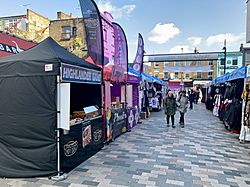Inverness Street Market facts for kids

Inverness Street Market, London—2020
|
|
| Location | Camden Town, Camden, Greater London |
|---|---|
| Coordinates | 51°32′23″N 0°08′36″W / 51.539734°N 0.143363°W |
| Address | Inverness Street |
| Opening date | 1851 |
| Management | Camden London Borough Council |
| Owner | Camden London Borough Council |
| Environment | Outdoor |
| Goods sold | Fashion, Food, Souvenirs |
| Days normally open | Every day |
| Website | camden.gov.uk/markets |
The Inverness Street Market is a lively outdoor market located in Camden Town, North London. It's a fun place to explore and find different items. The local council, Camden London Borough Council, manages the market and gives permission for traders to set up their stalls.
Contents
Discovering Inverness Street Market's Past
How the Market Began (1851–1867)
The street where the market is now was first named Wellington Street. This was to honor a famous military leader, Arthur Wellesley, 1st Duke of Wellington. Later, in 1937, its name changed to Inverness Street. This new name honored George VI of the United Kingdom, who was a king. Before he became king, he held the title of Earl of Inverness.
Inverness Street Market is a small part of what used to be a much bigger market. This larger market, called Camden Town Market, used to be on Camden High Street. It moved off the High Street in the late 1800s. This happened when horse-drawn trams became electric.
In 1851, a writer named Henry Mayhew described Camden Town Market. He said it had about 50 stalls. In the past, street markets like this were not strictly controlled. This allowed London to grow very quickly. Traders could easily move to new areas where people were settling. This made it easy for people to buy food and other goods. They did not have to travel far to big central markets.
In the early mornings, traders would load their carts at wholesale markets. They would then clean and sort their goods. After that, they would sell them in the new streets. Many of these market spots later became London's main shopping streets.
Police Look After the Market (1867–1927)
In 1867, a new law made it difficult for street traders. It almost stopped them from selling goods. But after public meetings and complaints in the news, the law was quickly changed. Traders were allowed to continue. However, the police now had the power to manage them.
Even in 1878, the market was still on the High Street. People described it as a busy place on Saturday evenings. It was filled with stalls and people buying what they needed. It truly felt like a marketplace.
Local Councils Take Over (Since 1927)
St Pancras Council (1927–1965)
In 1927, a new law changed how markets were managed. The police no longer controlled them. Instead, local councils started giving out special permissions, called licenses, to traders. From 1927 to 1965, the market was managed by the Metropolitan Borough of St Pancras.
A book about London's street markets mentioned Inverness Street Market briefly. It said the market was open only on weekdays. It mainly sold fruits and vegetables. A famous boxing trainer named George Francis worked at Inverness Street Market in the 1940s.
Camden Council (Since 1965)
In 1965, the St Pancras area became part of the London Borough of Camden. So, Camden Council took over managing the market.
In the mid-1980s, the market was doing very well. It had about fifty stalls. These stalls mostly sold fresh produce like fruits and vegetables. They also sold cheese, meat, fish, and items for the home.
By the mid-1990s, the market had fewer stalls, about thirty. The types of products were still similar. But the stalls closest to Camden High Street started selling souvenirs.
Until 2009, there were bus stops very close to Inverness Street Market. These stops were removed in 2009. This meant people had to walk further from the nearest bus stops. Also, after many years, the council asked traders to remove their stalls from the street when the market was closed. This was due to complaints from residents and shop owners. Because there was no place to store the stalls, many had to be destroyed. This caused many fruit and vegetable traders to leave the market.
Until the 2010s, the market mainly sold fresh produce. But as nearby shops turned into bars and restaurants, the market changed too. It started selling more clothing, souvenirs, and street food. This was to serve the many tourists and people enjoying Camden's nightlife.
After 2010, the market mostly sold clothing, souvenirs, and street food. The very last fruit and vegetable stall left a few years after the nearby bus stop was closed.
Getting to the Market
By Bus
Many bus routes can take you close to the market. These include routes 24, 27, 31, 88, 134, 168, and 274.
By Train or Tube
The market is very close to Camden Town tube station. It is also not far from Camden Road railway station.
Images for kids



